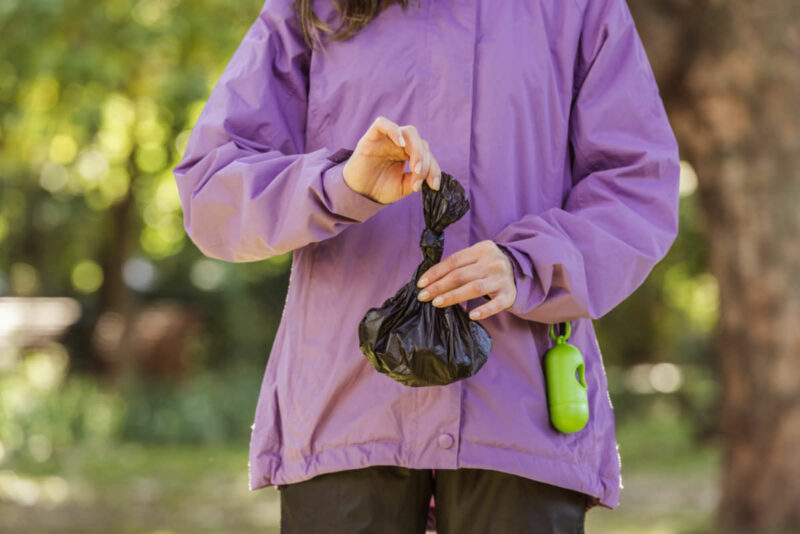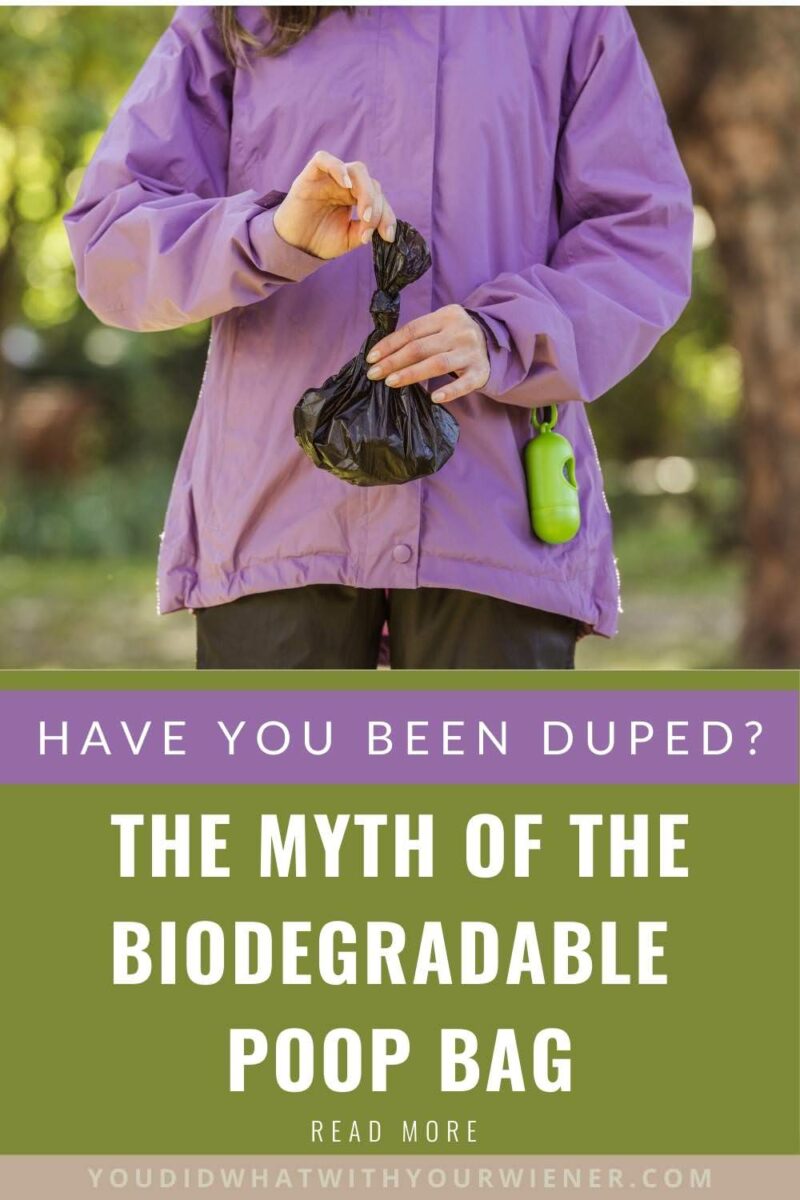Have You Been Duped? The Myth of the Biodegradable Poop Bag
For those of us who try to be environmentally responsible pet owners, biodegradable dog poop bags seem like a smart choice.
However, biodegradable bags may not be as helpful to the environment as you thought.
Much of the information out there is misleading at best and deceptive at worst.
UPDATED: Originally Published June 4, 2011

In my previous career, I was a surface water quality specialist.
Because I was also a dog owner, the two interests combined and I was deemed the “dog poop queen” at work.
I studied everything I could about how dog poop negatively affects our waterways and the best ways to dispose of it.
One hot button issue for me is the biodegradable poop bag so I wanted to clear a few things up.
What Are Biodegradable Poop Bags?
What does it mean when a dog poop bag is labeled biodegradable?
According to the Oxford Dictionary, biodegradable means “[a substance or object] capable of being decomposed by bacteria or other living organisms“.
These organisms – microorganisms to be technical – include bacteria and fungi.
The substance has to be organic – a carbon-based compound found within the environment – in order to decompose.
Decomposition means breaking down, or causing to break down, into component elements or simpler constituents.
Specifically, the result of biodegradation or organic matter is water, carbon dioxide, and biomass.
In order for packaging products or materials to qualify as biodegradable, they must completely break down and decompose into natural elements within a short time after disposal – typically a year or less.
Petroleum-based biodegradable bags are made from plastic with other chemicals added (including heavy metals) that cause the plastic to break down and disintegrate over time when exposed to sunlight and heat.
Note: you may also see the term “oxo-biodegradable”, which is another label for the same thing I’m describing here.
The Problem With Biodegradable Items
First, most Biodegradable bags are still plastic bags (bags made from, say, corn starch, are different and not as common).
One to many
It’s just that chemicals have been added that help the bag break down into smaller pieces over time.
So one bag basically breaks down into hundreds or thousands of microscopic plastic pieces that can take many decades to disappear.
Biodegradable poop bags just become microplastics that are almost impossible to see and remove from the environment.
It breaks down, but when?
Second, the thing about the term “biodegradable” is that it does not reference, or require, a specific time scale.
An item, or its subsequent smaller pieces/components, could take decades to fully decompose and return to nature.
Conditions have to be right
Third, materials need certain conditions to biodegrade.
Specifically, they need water and sunlight to break down (ie. won’t break down in water or most commercial landfills).
Manufacturers will have you believe that biodegradable bags are better for the environment because they break down, or disintegrate, in the environment.
This is unlike plastic bags which will remain for possibly hundreds of years.
However, really, the true difference is that one generally stays whole (plastic shopping bag) and the other breaks into thousands of tiny pieces you can no longer see (biodegradable bags).
These smaller pieces are harder to remove from the environment than an intact plastic bag.
What Happens When Your Dog Poop Bag Goes to the Landfill?
The most accepted thing to do with your bagged dog poop is to throw it in the trash.
Doing this keeps dog poop, and bacteria, out of our waterways. Ding….another point for the environment.
In the old landfill days, people dumped stuff in a pit in the ground.
Much of the stuff decayed, releasing methane and other gasses into the atmosphere.
When rain passed through the decaying matter, “trash juice”, called leachate, was produced and soaked into the ground.
This leachate contained contaminants that made their way into groundwater and polluted our drinking water.
As population and trash production grew, this posed a big problem for the environment and those in the waste industry.
The solution? Lining the bottom of the landfill with impervious (means it won’t let air or water through) clay and compacting the trash.
The removal of this air meant the trash in the landfill wouldn’t break down.
So, your happy little bag of poop makes its way into a garbage truck and to a landfill.
At the landfill, garbage is compacted, which robs the trash of air and sunlight that is essential for biological and ecological functions……LIKE DECOMPOSITION.
So, I hate to tell you, but those little poop bags are going to sit there for basically eternity until some future archaeologist finds them.
Is There Any Benefit to Biodegradable Poop Bags?
You may be left wondering if it even matters if the poop bags you use are biodegradable.
What is true is that picking up your dog’s poop helps protect our water resources, but that is true whether you use a traditional plastic bag or a biodegradable one.
There may be other related benefits though.
Several companies that make biodegradable bags care about the environment and operate in an environmentally-responsible way.
Many also give back to the community by donating to animal shelters, rescues and non-profit organizations.
Also, biodegradable poop bags are often made with recycled plastic.
Am I Being Duped?
The truth is, the protection of the environment has become mainstream and companies want to capitalize on that.
If they slap “earth friendly” or “biodegradable” on something, it will appeal to environmentally conscious consumers and they will likely sell more bags.
Some hope that you think biodegradable means something that 100% returns to nature within a short period of time and don’t know that’s not typically the case.
Not all companies are purposely trying to mislead you though.
It may just be a lack of clarification issue.
As companies and the public learn more about the difference between biodegradable, compostable, and degradable, some brands are changing their messaging and trying to be clearer.
For example, there is one poop bag company that used to list their bags as biodegradable and claimed they broke down in anaerobic landfills (the compacted kind I mentioned earlier).
But, as I said, no bag breaks down in a landfill without oxygen and their bags are petroleum based with additives that help them break down into microplastics.
Their packaging and messaging no longer says “biodegradable”.
Note: This brand then released a compostable poop bag, which seems more in-line with their original intention of being an environmentally friendly solution for picking up pet waste.
What is the More Environmentally Friendly Choice?
Now that you understand that biodegradable doesn’t mean, in most cases, that something “turns back into dirt”, and that it can still harm the environment, you may be looking for alternatives.
What are some ways you can pick up your dog’s poop in a more environmentally-responsible manner?
Compostable/Bioplastics
Compostable plastics are a subset of biodegradable plastics, defined by the standard conditions and timeframe under which they will biodegrade.
All compostable plastics are biodegradable, but not all biodegradable plastics would be considered compostable (source).
Compostable bags, which are now often referred to as “bioplastics” to make things clearer, are bags made out of plant-based materials, such as vegetable starches, wood pulp, lactic acid, or soy proteins.
These bags can indeed decompose into the soil-like organic substance we know as compost under the right conditions.
But, again, the key is that they need the right conditions – like heat and airflow – to break down so they also will not do that in compacted landfills.
Unfortunately, most municipal composting facilities do not accept pet waste so you can’t send them there to be “turned to dirt” either.
You may be wondering if you can put them in your backyard compost bin.
Unfortunately, many home composting setups do not generate high enough heat to fully break down these bags and the bacteria in pet waste.
If you want to try though, be sure not to use the resulting soil in your garden where you grow food.
Bioplastics are a good option if you want to avoid supporting the use of petroleum-based products though.
Reuse other bags
There is a saying that the sincerest form of recycling is reuse.
While many plastic dog poop bags are made of recycled plastic, you can skip the energy and water required for processing them by simply repurposing a plastic bag you already have.
Final Thoughts
Many so-called biodegradable dog poop bags contain plastic.
If they finally do “degrade”, they will leave behind microplastics that could take hundreds of years to decompose.
However, when sent to a municipal landfill, they will rarely break down at all.
Landfills are designed to prevent that so trash doesn’t contaminate the underlying soil and groundwater.
Although many dog poop bags are made with recyclable plastic, they aren’t really a benefit to the environment.
At least not in the way, or to the degree, that most people think.
Plant-based compostable bags are a better choice for the environment if you want to avoid using petroleum-based products, compost at home (but the soil will not be suitable for a garden), or your local municipal composting facility accepts pet waste (most do not).
You can also help reduce waste in the first place by reusing plastic bags you already have around the house (at least it’s used twice before being thrown away).
If you are cleaning up pet waste in your yard, consider shoveling it into a bucket and then hiring a pet waste disposal company that composts to haul it away.


About the Author
Hi, I’m Jessica. I’ve been studying the Dachshund breed since 2007, owned 3 of my own, and shared in the lives of thousands of others through their owner’s stories. When I’m not sharing what I know on this blog, you can find me hiking, camping, and traveling with my adventurous wiener dogs.

My composting facility accepts pet waste, though not pet hair. They must get to a high enough heat, though, because they also give away and sell their composted waste.
I do try to use the biodegradable bags, but don’t do it in the summer/warm weather, because the heat of the sun on our big green compost bin causes the little baggies of poop to explode and deteriorate, leaving my bin filthy and nauseating. If anyone has suggestions of brands that don’t do that, i’d switch to that brand, at least on a trial basis.
I imagine you won’t find a compostable bag that doesn’t do that. That is exactly what compostable bags are supposed to do…break down with heat, moisture and sunlight. I think the typical timeline of breakdown is an average of 14 days under tthe intended conditions.
That’s awesome that your facility takes pet waste. I wish ours did. Then by dilemma would be solved.
our composter gets emptied up every week… so apparently the bin fast-forwards the process in an awful terrible way.
I think it’d be worthwhile to modify the composting facility to allow it… after all, for the same reason that you should pick up your pet’s waste (there’s alot of it, from alot of dogs), the landfills must have ALOT of poop in them, taking up space and stinking things up.
Goodness, all this poo and what do we do? I wish our town had composting and recycling and all that. We do the best we can without it though. The biodegradable myth applies to more than just baggies I’m afraid.
What do you have in mind?